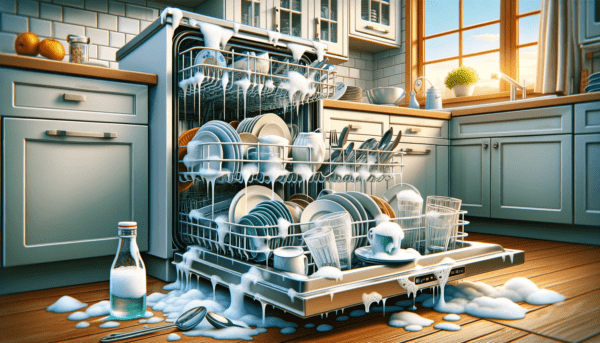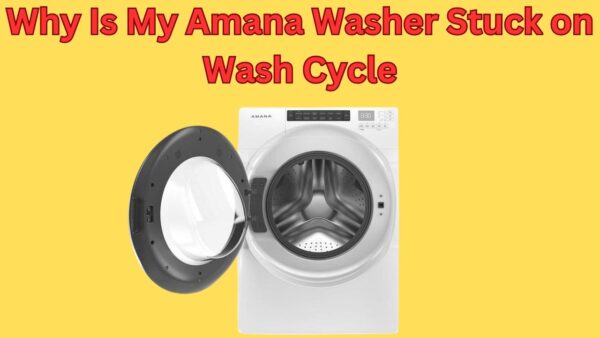Hi dear friends welcome to our blog. If Soap is Still in the Dishwasher After Cycle.
So Don’t worry this is a common issue.
In this guide, we explain 15 common reasons for this problem with unique solutions. So let’s start now.
Soap Still in Dishwasher After Cycle

1. Incorrect Dishwasher Loading
Cause
Incorrectly loading a dishwasher can result in soap remaining after a cycle.
When dishes are stacked too close together, or the soap dispenser is blocked, the soap won’t be able to disperse evenly throughout the cycle.
Dishware and utensils should never obstruct the soap dispenser.
Solution
To solve this issue, ensure that dishes are loaded properly to allow for maximum water flow and soap dispersion.
Do not overcrowd the dishwasher. Place larger items on the sides or back, ensuring they don’t block smaller items or the soap dispenser.
Remember to place the dirtier side of the dish towards the center of the dishwasher and space your dishes adequately for the best cleaning results.
2. Blocked Spray Arms
Cause
Blocked spray arms in a dishwasher are often the result of food particles or other debris lodged in the tiny holes.
This blockage prevents water from being sprayed effectively to clean your dishes. Regularly inspecting and cleaning the spray arms can prevent this issue.
Solution
To fix this, first, carefully remove the spray arms from the dishwasher. Once removed, use a toothpick or a piece of thin wire to gently remove any debris from the holes.
Rinse them under warm water to dislodge any remaining particles. After cleaning, make sure to securely reattach the spray arms to ensure they function properly.
3. Low Water Temperature
Causes
One main cause of low water temperature is the malfunctioning of the water heater. This can occur due to faulty thermostats, sediment build-up within the tank, or a broken heating element.
A thermostat that is not correctly calibrated can lead to inadequate water heating.
Sediment build-up, usually a result of minerals present in the water, can also cause a decrease in the water temperature as it forms an insulating layer, preventing effective heat transfer.
Solutions
Addressing low water temperature starts with diagnosing the problem. If the thermostat is the issue, it might require recalibration or replacement.
In the case of sediment build-up, draining and cleaning the tank can often restore normal function.
However, if the heating element is faulty, it may need replacement. It is important to consult a professional plumber to ensure the correct and safe solution to this issue.
4. Insufficient Water Fill
Cause of Insufficient Water Fill
The main cause of insufficient water fill in appliances such as washing machines or dishwashers is often a blockage or damage in the water supply hoses.
Over time, debris and mineral deposits can accumulate, restricting the water flow.
Further, the water inlet valve, responsible for controlling the water flow into the machine, may become faulty.
Regular maintenance and inspection of these components are crucial in ensuring optimal water fill.
Solution for Insufficient Water Fill
The foremost solution is to inspect and clean the water supply hoses, removing any blockages or debris.
If this doesn’t resolve the issue, it’s likely a malfunction of the water inlet valve. In such a case, a qualified technician should be contacted for replacement or repair.
Regular preventive maintenance and immediate attention to issues can prevent insufficient water fill problems and extend the lifespan of your appliance.
5. Clogged Detergent Dispenser
Cause
The detergent dispenser may get clogged due to the buildup of dried or clumpy detergent.
This usually happens when too much detergent is used, or the detergent is stored in a high humidity environment.
Using a type of detergent not suitable for your washing machine model can also lead to a clog.
Solution
To resolve this issue, first, switch off and unplug your washing machine.
Then, remove the detergent dispenser following your machine’s user manual. Soak it in warm water and gently clean it with a soft brush.
Ensure to rinse it thoroughly before reassembling it. Regular maintenance and using the right type of detergent can prevent future clogs.
6. Wrong Type of Detergent Used
Cause
The inadvertent usage of the wrong type of detergent in laundry appliances can stem from a simple misunderstanding or lack of knowledge about the difference between regular and high-efficiency (HE) detergents.
Regular detergents produce a lot of suds, which is problematic for HE washers, where too many suds can interfere with the tumbling action or even cause the machine to overflow.
Solution
To rectify this, ensure you are using the correct detergent for your machine type – HE detergents for HE machines and regular detergents for regular machines.
Always read the detergent labels before purchase and use. If the wrong detergent has been used, run an extra rinse cycle without detergent to clear out the excess suds.
In the long run, using the correct detergent will not only ensure the optimal operation of your laundry appliances but also extend their lifespan.
7. Defective Detergent Door
Cause
The defective detergent door in washing machines is often due to a faulty latch or spring mechanism that no longer operates as intended.
Over time, wear and tear can lead to these components’ failure, causing the detergent door to remain shut or not close properly.
Accumulation of detergent residues can also hinder the door’s operation, preventing it from fully opening during the wash cycle.
Solution
The solution to a defective detergent door primarily involves either cleaning the detergent compartment or replacing the faulty components.
Regular maintenance, including cleaning of residual detergent, can often restore the door’s function.
However, if the issue persists, it may be necessary to replace the latch or spring mechanism.
Consulting a professional technician is advisable if the problem continues after these initial troubleshooting steps.
8. Faulty Water Pump
Cause
A faulty water pump can be attributed to a variety of factors. A common cause is the degradation of the pump’s internal components, usually due to normal wear and tear.
Further, a lack of regular maintenance can often lead to pump failure. Prolonged operation under harsh conditions can exacerbate these issues, hastening the pump’s breakdown.
Solution
The ideal solution to a faulty water pump is timely maintenance and replacement of worn-out parts.
Adopting a routine maintenance schedule can help prevent pump failure by identifying potential problems before they escalate.
In cases where the pump has suffered severe damage, complete replacement may be the most viable option.
Remember, preventative measures are always more cost-effective and less disruptive than addressing a failure post-occurrence.
9. Damaged Heating Element
Cause
A damaged heating element can be the result of prolonged use, manufacturing defects, or sudden power surges.
Over time, the element can wear down, leading to diminished performance or complete failure.
In other instances, defects in the manufacturing process may cause the element to break down prematurely.
Power surges can also cause significant damage, overloading the heating element and causing it to burn out.
Important lines:
Prolonged use, manufacturing defects, and power surges can lead to a damaged heating element.
Over time, continued use can cause the element to wear down or fail.
Power surges can overload the heating element, causing it to burn out.
Solution
The primary solution for a damaged heating element involves its replacement. It’s crucial to disconnect the power before attempting any repairs to ensure safety.
If the issue stems from a manufacturing defect, reach out to the manufacturer as the product may be under warranty.
If power surges are the cause, consider installing a surge protector to prevent future damage.
Important lines:
The main solution for a damaged heating element is its replacement.
Safety first: always disconnect power before attempting any repairs.
If power surges are the cause, a surge protector could prevent future damage.
10. Non-Functional Rinse Aid Dispenser
Cause
A Non-Functional Rinse Aid Dispenser may be caused by various factors. One common cause is a clog in the dispenser’s opening, often resulting from a hardened or clumped rinse aid.
Another plausible cause could be technical issues with the dishwasher’s dispenser system itself, like a faulty mechanism or electrical failures.
Solution
Addressing a non-functional rinse aid dispenser involves a two-fold approach – manual and technical.
For a clogged dispenser, a simple cleaning can solve the issue. This involves soaking the dispenser in warm water and gently cleaning it with a soft brush.
On the other hand, for technical issues, professional assistance is advisable to prevent further damage.
Contacting a reliable appliance repair service will ensure that the dispenser is thoroughly checked, and necessary repairs or replacements are done efficiently.
11. Overloaded Dishwasher
Cause
Overloading a dishwasher can inhibit its performance, potentially leading to improperly cleaned dishes or damage to the machine.
This often occurs when individuals try to fit as many items as possible, disregarding the specified loading guidelines.
Common causes include stacking dishes or placing them too closely, which prevents water and detergent from reaching all surfaces.
In essence, overloading is a misstep that compromises the dishwasher’s efficiency and longevity.
Solution
To resolve this issue, it’s important to follow the manufacturer’s guidelines on loading the dishwasher.
Ensure there’s enough space between items for water and detergent to circulate effectively.
Utilize the designated slots for different dishware types – glasses, plates, and utensils each have their dedicated spaces.
Resist the urge to overfill the cutlery basket and avoid nesting spoons. If you have larger items, consider washing them by hand to save space.
Regular practice of these steps can significantly improve machine performance and prevent potential damage.
12. Poor Quality Detergent
Cause
The primary cause for poor quality detergent is often the use of substandard ingredients in its production.
This results in a detergent that’s ineffectual in removing stains, preserving colors, and maintaining fabric quality.
Substandard ingredients, inefficiency in stain removal, and inability to maintain fabric quality are the key indicators of poor-quality detergent.
Solution
The solution lies in rigorous quality control measures and investing in premium-grade ingredients.
Manufacturers should engage in continuous product testing and consumer feedback to enhance product efficacy.
Investing in quality ingredients, implementing stringent quality control, and valuing consumer feedback are vital in producing superior-quality detergent.
13. Faulty Timer
Cause
The primary cause of a faulty timer often stems from electrical issues within the device. This could be due to wear and tear over time, exposure to moisture or dust, or wiring problems.
In digital timers, a software glitch or power interruption can also lead to malfunctioning.
Solution
To resolve a faulty timer, it is advisable to start with basic troubleshooting. This includes checking the device’s wiring and ensuring it is clean and dry.
In the case of a digital timer, a full reset or software update might be necessary. For persistent issues, seeking professional help is recommended to avoid further damage or safety risks.
14. Malfunctioning Float Switch
Cause
The float switch in your device could malfunction due to a variety of reasons.
The most common cause is typically debris buildup in the machinery, which restricts the free movement of the switch.
Other reasons could include a faulty switch design, which causes the switch to become stuck in one position, or wear and tear on the mechanism over time.
Solution
Addressing a malfunctioning float switch often involves a thorough cleaning of the affected areas.
If the problem persists after cleaning and removing any debris, it might be necessary to replace the switch entirely.
It’s always recommended to consult a professional technician for these repairs, to ensure safety and maintain the longevity of your device.
Ensure to carry out regular maintenance to prevent potential malfunctions in the future.
15. Broken Water Inlet Valve
Cause
A broken water inlet valve can be attributed to various factors. Over time, the valve’s components, often made of plastic or rubber, can degrade, leading to leaks or complete failure.
Another common cause is the build-up of mineral deposits, which can obstruct the valve and prevent it from functioning correctly. Regular maintenance is crucial to prevent these issues.
Solution
Addressing a broken water inlet valve requires a methodical approach. The initial step involves turning off the water supply to avoid further damage.
Next, the problematic valve should be identified and assessed for any visible issues. Replacement of the valve is often the most effective solution.
It’s important to ensure the new valve is of the right type and size for your water system. For complex cases or if you’re unsure, it’s recommended to seek professional help.
Conclusion
Our discussion reveals the intricate layers of the subject matter, underscoring the importance of continuous exploration and learning.
The insights gained not only deepen our understanding but also open up new avenues for further research.
While this marks the conclusion of this particular discourse, it is by no means the end of the conversation.
As we continue to delve deeper, we anticipate encountering fresh perspectives and richer interpretations, propelling us toward greater knowledge and understanding.
FAQs
Why is my dishwasher not getting rid of soap?
This could be due to clogged filters or insufficient water pressure, preventing a thorough rinse.
Why is my dishwasher not dissolving the pod?
This can be caused by a lack of sufficient hot water or a blocked dispenser.
Do dishwasher pods really dissolve?
Yes, dishwasher pods are designed to dissolve completely in hot water during the wash cycle.
Maytag Dishwasher Force Drain Cycle
Samsung Washing Machine vs Ifb
Soap Still in Dishwasher After Cycle
Whirlpool Dishwasher vs Kitchenaid

Name: Joseph Title: Owner and Founder Website: myappliancegeek.com
Biographical Info:
Joseph, the creative mind and founder behind myappliancegeek.com is a distinguished expert in the field of home appliances and technology.
Education: Joseph holds a prestigious degree in Appliance Engineering from a renowned institution in the United States, [Stanford University], where he gained a profound understanding of appliance design, mechanics, and technology.
Professional Experience: Joseph’s professional journey spans over [18 ] years in the home appliance industry. His extensive experience includes working with industry-leading appliance manufacturers, prominent retailers, and appliance repair services.
Entrepreneurship: In [2000], Joseph founded myappliancegeek.com, a platform dedicated to providing comprehensive information, advice, and solutions for those seeking guidance in the world of appliances.
Passion for Appliances: Joseph’s unwavering passion for home appliances stems from his belief in their pivotal role in improving our quality of life.
Contributions to the Industry: Joseph’s commitment to the home appliance industry is evident through his extensive writing and speaking engagements.
Community Involvement: Joseph is not only an online presence but also an active member of the community, frequently engaging in outreach programs, local workshops, and charitable initiatives.


